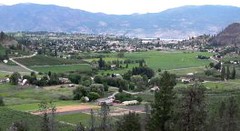I find this interesting. This is an exerpt from Mayor Tom Johnson's Report, November 8, 2004, as found in the Minutes, from the Municipal Website:
MAYOR’S REPORT (Nov.8, 2004)
He summarized the reasons behind the recent fact-finding delegation to California. He noted that our Official Community Plan has shown an expansion on our north-west boundary for more than 15 years. Agur Developments is looking at partnering with the Brandenburg Development Group from California on a proposed 27-hole golf course and 1500 residential units. During the visit to California our delegation
saw similar developments by this group and met with local government
officials. Mayor Johnston answered a number of questions with respect to
water supply, the ALR, and why the District is looking at this expansion
now. He noted that the development has its own water supply,
does not involve ALR land, and that the project has been on the books for approximately fifteen years.
Since that time, Summerland's boundary has been extended. I think as citizens of this town, we need to be kept more informed as to the implications of this. If a development takes place within city boundaries, receives the proper approvals, and pays taxes, will it have rights to power and a Municipal water source?
This is an exerpt from the Polaris Consulting Firm of BC:
The Land Development Process, p.2
It is also not uncommon for local governments to have a Development Cost Charge Bylaw in place, which means that while the local government takes responsibility for the installation and maintenance of utility systems, developers are required to pay fees at the time of the development to offset these infrastructure costs...
If you are in a municipality or an urban area your potable water is most likely supplied by the community. This could be in the form of a municipal service, a function of the regional district or a water improvement district. In each case, the Local Government Act governs the structure and the Ministry of Health Services
regulates the quality of the water.
Mayor Tom Johnson has referred to the fact that this development will have its own water supply; however, once the water distribution infrastructure has been built and paid for, will it then become the municipality's responsibility to maintain? What happens if the wells run dry? Will the municipality be responsible for ensuring potable water to this new community?
In addition, the private developer's Agent has now made an ALR exclusion application of adjacent Municipal Land. Hmmmm. How things change. This community needs to be kept up to speed.

